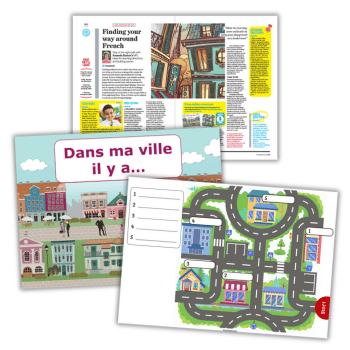PDF lesson plan and accompanying resources
KS2
Years 3-6
Teaching children how to ask for directions in French can be a lot of fun. It involves looking at life outside the classroom and creates opportunities for moving around.
If you’re feeling brave, and weather permits, make the learning more authentic by using your playground as a model town, with posters stuck to fenceposts and cones indicating buildings.
There are lots of cognates in the French words for buildings, so these shouldn’t pose a challenge, but it’s worth emphasising the pronunciation to discourage children from anglicising them. The buildings covered in this lesson include: cafe, museum, supermarket, train station, church, bridge, castle, library, swimming pool and stadium.
These activities can be adapted to suit any modern foreign language.
Directions in French learning objectives
- Say the names of places in the town centre
- Give and ask for directions
- Develop listening and speaking skills
- Develop teamwork skills
Download includes
- PDF lesson plan
- French place names PDFs (labelled and not labelled)
- French place names PowerPoint (labelled and not labelled)
- PDF town map to use when teaching directions
Starter activity
Tell the children that a French visitor is coming to stay. This could be a puppet, soft toy or other character that you have to hand.
Ask pupils to work in pairs to come up with a list of places in the town, in English, which the guest might like to visit, or which they would see if they walked around.
These might include the park, supermarket, cinema, railway station, restaurant, café, post office, swimming pool, library, school and church.
Can anyone remember the French words for these places from previous lessons, or from their holidays? ‘Restaurant’ and ‘café’ should be easy ones!
Point out that these are French words ‘borrowed’ by English, and highlight the different pronunciations.
Dr Amanda Barton is a freelance writer who has taught MFL in primary and secondary schools. She is co-author of Teaching Primary French and Teaching Primary Spanish (Bloomsbury).














